商务统计学Ch01PPT课件
商务统计学第一章

xx年xx月xx日
contents
目录
• 引言 • 商务统计学基本概念 • 数据类型与数据收集 • 数据的整理与可视化 • 概率论基础
contents
目录
• 统计推断基础 • 相关分析与回归分析 • 时间序列分析与预测 • 统计决策理论
01
引言
课程简介
商务统计学是统计学在商业和经济领域的应用,旨在培养学 生在商业和经济领域运用统计学方法解决实际问题的能力。
统计学的发展经历了描述性统计学、推断性 统计学和现代统计学三个阶段。
描述性统计学主要是对数据进行描述性统计 指标的计算和数据的可视化,推断性统计学 主要是通过样本信息对总体进行推断和分析 ,现代统计学则涉及到数据挖掘、机器学习
、时间序列分析等多个方面。
02
商务统计学基本概念
统计学的定义
统计学是一门收集、整理、分析和 解释数据的科学。
基于一组变量预测另一个变量的值。
选择变量、收集数据、建立模型、检 验模型、应用模型。
03
回归分析的基本假设
线性关系、误差项独立同分布、误差 项无序列相关性、解释变量与误差项 无多重共线性。
线性回归模型
线性回归模型的定义
一种用于预测的模型,将解释变 量与响应变量之间的关系建模为 线性关系。
线性回归模型的参数 估计
数据收集的方法
调查问卷
通过邮寄、网络或现场发放问卷, 收集相关数据
观察法
记录现场观察到的数据,如销售额 、客流量等
实验法
通过实验来测试不同因素对变量的 影响,如A/B测试
现有统计数据
从政府、企业或第三方机构获取相 关统计数据
数据收集的步骤
01
商务统计学ppt课件
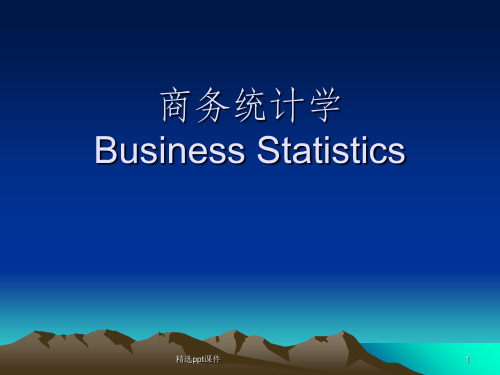
精选ppt课件
17
统计的应用领域
hydrology(水文学)
industry(工学)
linguistics(语言学)
literature(文学)
manpower planning(劳动力计划)
management science(管理科学)
marketing(市场营销学)
medical diagnosis(医学诊断)
称
离散变量:取有限个值 连续变量:可以取无穷多个值
精选ppt课件
30
统计中的几个基本概念
总体(参数) 平均数 μ 标准差 σ 比例 Π
样本(统计量) ¯x s p
精选ppt课件
31
几个常用的统计软件 (software)
典型的统计软件
SAS SPSS MINITAB STATISTICA EXCEL
所研究的全部元素的集合,其中的每一个元素称为 个体
分为有限总体和无限总体
有限总体的范围能够明确确定,且元素的数目是有限的 无限总体所包括的元素是无限的,不可数的
2、样本(sample)
从总体中抽取的一部分元素的集合 构成样本的元素的数目称为样本容量
精选ppt课件
28
参数和统计量
1、参数(parameter)
商务统计学 Business Statistics
精选ppt课件
1
参考书籍:
• 商务统计学 戴维.M.莱文等著 贾俊平改编
•
中国人民大学出版社
• 统计学原理 谢启南 主编 暨南大学出版社
• 统计学原理 贾俊平 中国人民大学出版社
精选ppt课件
2
成绩评定方法
• 1.闭卷考试成绩(70%) • 2.平时作业、考勤和上机。(30%)
商务统计学教学课件

(三)指标体系中指标的分类
• 1、水平指标——(1)存量指标与流量 指标,(2)实物指标与价值指标。
• 2、比率指标——(1)比例相对指标, (2)比值相对指标,(3)动态相对指 标,(4)弹性相对指标,(5)强度相 对指标。
(四)指标体系设计的内容
1、确定统计指标体系的框架; 2、确定每一个指标的内涵和外延; 3、确定每个统计指标的计量单位; 4、确定每个统计指标的计算方法。
N0 CNn
(四)泊松分布
泊松分布是稀有事件出现次数的理 论分布模型,如自然灾害、意外事故、 机器故障等事件出现的次数都近似地服 从泊松分布。泊松分布概率模型为:
Pxmm e
m!
六、连续变量概率分布模型
连续型随机变量的取值范围可以是数轴上的 某个区间,也可以是整个数轴。由于它可以取 无穷多个不同的数值,所以描述其概率分布的 最完善方法是概率函数式。在理论分析中,描 述连续变量概率分布的最常用的概率函数式是 概率分布密度函数。
P x n 1 C n n 1p n 1 q n 0
(三)超几何分布
假设0-1总体中共有N个个体,其中取
“是”值的个体有N1个,取“非”值的 个体有N0个。现从不放回地随机抽取n个 个体,记x为取“是”值的个体数目,则
其 中 恰 有 n1 个 个 体 取 “ 是 ” 值 、 且 有 n0=n-n1个个体取“非”值的概率为:
二、统计学的作用
• (一)统计学在科学研究中的作用——提出假 说并判定假说的正确与否
• (二)统计学在生产中的作用——通过试验分 析找出最佳工艺,并对生产过程进行统计质量 控制。
• (三)统计学在管理中的作用——抽样调查了 解社会与市场,为决策提供依据;并可建立各 种社会与经济发展模型,定量地模拟社会与经 济的运行,既可分析社会与经济的发展及其结 构变化,又可进行政策效果的评价。
统计学(中英文)_ch01

Business Statistics, A First Course (4e) © 2006 Prentice-Hall, Inc.
Chap 1-12
∑X
n
i
Business Statistics, A First Course (4e) © 2006 Prentice-Hall, Inc.
Chap 1-8
Inferential Statistics 推断统计
Estimation 估计 e.g., Estimate the population mean weight using the sample mean weight 例如:利用采样的平均重量估计人口的平均体 重 Hypothesis testing 假设检验 e.g., Test the claim that the population mean weight is 120 pounds 例如:根据测试的要求,人口平均体重是120 磅
英文翻译乃自己所做, 英文翻译乃自己所做,有错误 之处请自行查证。 之处请自行查证。
Business Statistics, A First Course (4e) © 2006 Prentice-Hall, Inc.
Chap 1-1
Business Statistics, A First Course
Defined descriptive vs. inferential statistics 描述性统计和推理统计 Reviewed data types 回顾数据类型
♦ ♦ ♦ ♦
Categorical vs. Numerical data 绝对的和数值的数据 Discrete vs. Continuous data 离散的和连续的数据
商务与经济统计ppt第1章

Slide 7
数据、数据集、个体、变量和观测值
个体
公司
变量
股票 年销售额 每股盈余 交易所 (百万美元) (美元)
Dataram
NQ
EnergySouth
N
Keystone
N
LandCare
NQ
Psychemedics
N
73.10 0.86 74.00 1.67 365.70 0.86 111.40 0.33 17.60 0.13
Slide 13
度量尺度
间隔尺度 如果数据具有顺序尺度的特征,同时两个顺序之间 有固定的间隔时,可以用间隔尺度来度量。
间隔尺度永远是数字型的数据。
© 2011 Cengage Learning. All Rights Reserved. May not be scanned, copied or duplicated, or posted to a publicly accessible website, in whole or in part.
Slide 12
顺序尺度
度量尺度
例子: 大学生可以按照年级利用非数字型标签来排序,
比如大一、大二、大三或者大四。
也可以用数字标签来表示年级,如1代表大一, 2代表大二,以此类推。
© 2011 Cengage Learning. All Rights Reserved. May not be scanned, copied or duplicated, or posted to a publicly accessible website, in whole or in part.
Slide 2
统计
提供均值、中位数、百分比、次序等数字特征用以描述 商务和经济形势。
统计学CH01_英文教材

1.8
Example 2.6 Stats Anxiety
Frequency
30 20 10 0
50
Histogram
60
70
80
Marks
90 100
Copyright © 2009 Cengage Learning
1.9
Descriptive Statistics
Descriptive statistics deals with methods of organizing, summarizing, and presenting data in a convenient and informative way.
A large university with a total enrollment of about 50,000 students has offered Pepsi-Cola an exclusivity agreement that would give Pepsi exclusive rights to sell its products at all university facilities for the next year with an option for future years.
Chapter One
What is Statistics?
Copyright © 2009 Cengage Learning
1.1
What is Statistics?
“Statistics is a way to get information from data.”
Copyright © 2009 Cengage Learning
Copyright © 2009 Cengage Learning
戴维商务统计学第7版英文版教学课件BSFC7e_CH01
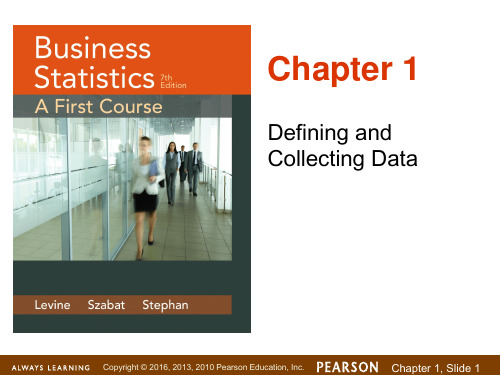
Chapter 1, Slide 5
Collecting Data Correctly Is A ritical
Task
DCOVA
▪ Need to avoid data flawed by biases, ambiguities, or other types of errors.
▪ Results from flawed data will be suspect or in error.
DCOVA
▪ A marketing research analyst needs to assess the effectiveness of a new television advertisement.
▪ A pharmaceutical manufacturer needs to determine whether a new drug is more effective than those currently in use.
Sources of data fall into five categories
DCOVA
Data distributed by an organization or an individual
The outcomes of a designed experiment
The responses from a survey
▪ An auditor wants to review the financial transactions of a company in order to determine whether the company is in compliance with generally accepted accounting principles.
商务统计学PPT课件
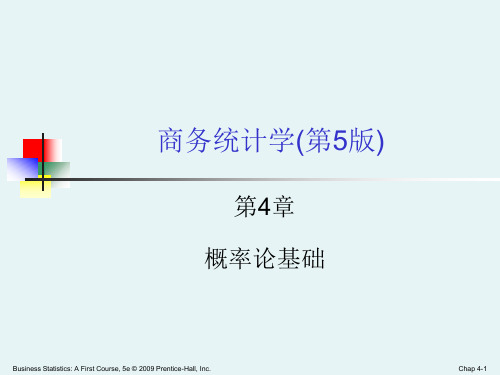
Business Statistics: A First Course, 5e © 2009 Prentice-Hall, Inc.
Chap 4-4
先验概率例子
找出从一副标准的52张扑克牌中选出脸牌(J、Q和K) 的概率。
脸牌的概率=X/T=脸牌总数/总牌数 =12张脸牌/52张牌数 =3/13
黑牌 红牌 总计
Business Statistics: A First Course, 5e © 2009 Prentice-Hall, Inc.
1点 非1点 总计
2
24
26
2
24
26
4
48
52
样本空
2间24来自224Chap 4-9
显示事件事件
韦恩图
令 A = 1点 令 B = 红牌
A
A ∩ B = 1点且 红牌
例如P(K且黑桃)
Business Statistics: A First Course, 5e © 2009 Prentice-Hall, Inc.
Chap 4-11
互斥事件
互斥事件
不能同时发生的事件 例子: 从一副牌中抽出一张牌
A = 方块q; B = 梅花q 事件 A 和 B 为互斥事件
Chap 4-3
判定概率
有三种方式判定不确定性事件概率:
假设各种 结果出现 的可能性 都是一样 的
1. a 先验概率 --基于预先掌握的知识对事件发生的概率做出推测。
事件发生的概率=X/Y 其中X表示使某事件发生的结果数量,Y表示所有可能出现的结果总数。
2. 经验概率
事件发生的概率=使其发生的事件数量/基本事件总数。
现代商务数据统计学部分课件

二、市场体系
任何商务活动都与市场体系密切相关。这就是说,市场的理解还必须从市场体系的角 度出发,才能对市场有一个充分地认识。
从严格意义上说,市场体系既包括市场运行体系又包括市覆盖行体系。市场运行体系包 括市场机制、市场体制等。覆盖体系是由许多相互联系、相互制约的市场组成的。它包括主体 市场、客体市场、时间市场和空间市场。这些市场构成了多维立体的市场结构。因此 市场体
系应主要包括:市场机制、市场体制、市场结构。这就是说,一个完备的市场体系是由完备
的市场机制、完备的市场体制和完备的市场结构所构成。 市场机制:是指市场上直接发挥作用的价格、供求、竞争、税收、利率等诸因素所形成
的一个有机制约体系。 市场体制:是指市场的管理组织体系及其一系列管理制度的总称。 市场结构:是一个多维立体的市场结构。 就目前而言,不论是市场机制还是市场体制乃至市场结构都需要进一步完善。我国只有
1、 实物形态市场 实物形态市场上所交换的商品都是硬件商品。按照硬件商品的最终用途不同,实物形态市 场可分为:生产资料市场和生活资料市场。
2
(1) 生产资料市场 生产资料是指生产、加工企业对其进行再加工,而不能用于生活消费的中间产品,人们也 称之为工业品。 ① 生产资料的分类。我们所以对生产资料进行分类,其目的就在于了解不同的生产资料。 因为,不同的生产资料在物质生产过程中的地位与作用不同,生产消费者的市场购买行为也不 同。按照生产资料在物质生产过程中的地位与作用不同,可将生产资料划分为:主要原材料、 辅助材料和机械设备。 主要原材料。主要原材料是指构成产品实体的材料。如,建筑业在生产过程中耗用的砖、 瓦、沙、石和钢材等就构成了建筑产品的是实体. 辅助材料。辅助材料是指未构成产品实体并在生产过程中被耗用掉的材料。辅助材料是一 种与主要材料相结合,能使主要材料发生物理或化学变化的材料。如照明设备、机械设备上的 皮带以及机械加工使用的润滑油等,都是辅助材料。 机械设备。机械设备是指在生产过程中,作为劳动手段所使用的通用设备和专用设备。如, 加工制造业中使用的车床、刨床等就是通用设备;而采掘行业中使用的钻孔机、洗煤机等就是 专用设备。 按照生产资料本身的自然属性分类,可将生产资料分为:金属材料、电工材料、化工材料、 建材、机电设备等。 此外,生产资料还可以按其使用方向不同分为:生产用生产资料、维修用生产资料、储备 用生产资料等。 ② 生产资料市场的特点
现代商务统计学部分课件

现代商务统计学部分课件《现代商务统计学》第一篇总论第一章市场体系与商务统计第一节市场及市场体系一、市场的涵义人们对市场涵义的理解,是随着商务活动内容的不断丰富和发展以及人们认识的不断完善而逐步加深的。
因此,在不同的认识程度上对市场涵义的理解也是不同的。
(一)市场是商品交换的场所这种市场涵义的理解是人们对市场的最早的认识。
显然,这里的市场是一个地域概念。
据我国《易传·系辞下》记载,早在神农氏之世,“日中为市,致天下之民,聚天下之货,交易而退,各得其所”。
这就是我国最原始的市场。
这是一种狭义的理解,狭义的市场是指各种市场主体进行商品买卖的地方或进行商品交换的场所。
如,北京的西单商场、天津的圈业场、上海的中百公司、南京的“金鹰”公司等等。
(二)市场是商品交换和流通的领域,是交换关系的总和。
这种市场涵义的理解,是随着人们认识的不断提高而获得的。
随着社会分工的逐步细化,特别是货币出现以后,商品的生产与交换范围不断扩大,形成了商品的流通过程。
商品从生产领域要转移到消费领域必须经过流通流域。
在流通领域里,商品流通是以货币为媒介的商品交换过程,是商品交换过程连续进行的整体。
任何市场主体的买(卖)总是与其他的市场主体买(卖)连续在一起的,许许多多商品的买卖关系交织在一起,则形成了商品的交换过程和流通全局。
在这种市场涵义的理解中,市场既体现着商品买、卖双方与商务中介的关系,也体现着商务活动的管理机构与商品买、卖双方之间的关系。
(三)市场的实质是商品供求关系的总和这种市场的涵义是从广义角度来理解的。
从广义的角度理解,市场不仅是指商品流通领域,还应紧密联系整个社会再生产过程去分析商品供求关系。
从供求关系角度分析,所有的生产、经营者构成了供给主体,所有的购买者构成了需求主体(生产、经营者在购买商品时,则成为需求主体),供给主体与需求主体之间的关系则构成了市场中的商品供求关系的总和。
供给大于需求则形成买方市场,反之则形成卖方市场。
戴维商务统计学第7版英文版教学指南CH01_Levine7e_ISM
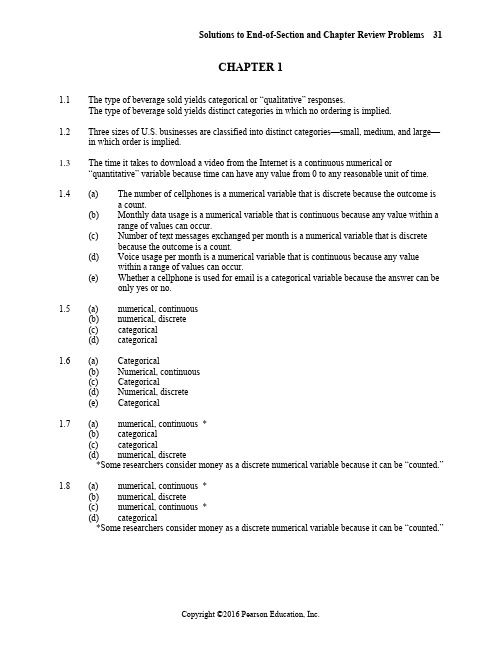
Solutions to End-of-Section and Chapter Review Problems 31CHAPTER 11.1 The type of beverage sold yields categorical or “qualitative” responses.The type of beverage sold yields distinct categories in which no ordering is implied.1.2 Three sizes of U.S. businesses are classified into distinct categories—small, medium, and large—in which order is implied.1.3 The time it takes to download a video from the Internet is a continuous numerical or“quantitative” variable because time can have any value from 0 to any reasonable unit of time.1.4 (a) The number of cellphones is a numerical variable that is discrete because the outcome isa count.(b) Monthly data usage is a numerical variable that is continuous because any value within arange of values can occur.(c) Number of text messages exchanged per month is a numerical variable that is discretebecause the outcome is a count.(d) Voice usage per month is a numerical variable that is continuous because any valuewithin a range of values can occur.(e) Whether a cellphone is used for email is a categorical variable because the answer can beonly yes or no.1.5 (a) numerical, continuous(b) numerical, discrete(c) categorical(d) categorical1.6 (a) Categorical(b) Numerical, continuous(c) Categorical(d) Numerical, discrete(e) Categorical1.7 (a) numerical, continuous *(b) categorical(c) categorical(d) numerical, discrete*Some researchers consider money as a discrete numerical variable because it can be “counted.”1.8 (a) numerical, continuous *(b) numerical, discrete(c) numerical, continuous *(d) categorical*Some researchers consider money as a discrete numerical variable because it can be “counted.”32 Chapter 1: Defining and Collecting Data1.9 (a) Income may be considered discrete if we “count” our money. It may be consideredcontinuous if we “measure” our money; we are only limited by the way a country'smonetary system treats its currency.(b) The first format is preferred because the responses represent data measured on a higherscale.1.10 The underlying variable, ability of the students, may be continuous, but the measuring device, thetest, does not have enough precision to distinguish between the two students.1.11 (a) The population is “all working women from the metropolitan area.” A systematic or randomsample could be taken of women from the metropolitan area. The director might wish tocollect both numerical and categorical data.(b) Three categorical questions might be occupation, marital status, type of clothing.Numerical questions might be age, average monthly hours shopping for clothing, income.1.12 The answer depends on the chosen data set.1.13 The answer depends on the specific story.1.14 The answer depends on the specific story.1.15 The transportation engineers and planners should use primary data collected through anobservational study of the driving characteristics of drivers over the course of a month.1.16 The information presented there is based mainly on a mixture of data distributed by anorganization and data collected by ongoing business activities.1.17 (a) 001 (b) 040 (c) 9021.18 Sample without replacement: Read from left to right in 3-digit sequences and continue unfinishedsequences from end of row to beginning of next row.Row 05: 338 505 855 551 438 855 077 186 579 488 767 833 170Rows 05-06: 897Row 06: 340 033 648 847 204 334 639 193 639 411 095 924Rows 06-07: 707Row 07: 054 329 776 100 871 007 255 980 646 886 823 920 461Row 08: 893 829 380 900 796 959 453 410 181 277 660 908 887Rows 08-09: 237Row 09: 818 721 426 714 050 785 223 801 670 353 362 449Rows 09-10: 406Note: All sequences above 902 and duplicates are discarded.1.19 (a) Row 29: 12 47 83 76 22 99 65 93 10 65 83 61 36 98 89 58 86 92 71Note: All sequences above 93 and all repeating sequences are discarded.(b) Row 29: 12 47 83 76 22 99 65 93 10 65 83 61 36 98 89 58 86Note: All sequences above 93 are discarded. Elements 65 and 83 are repeated.Solutions to End-of-Section and Chapter Review Problems 33 1.20 A simple random sample would be less practical for personal interviews because of travel costs(unless interviewees are paid to attend a central interviewing location).1.21 This is a probability sample because the selection is based on chance. It is not a simple randomsample because A is more likely to be selected than B or C.1.22 Here all members of the population are equally likely to be selected and the sample selectionmechanism is based on chance. But not every sample of size 2 has the same chance ofbeing selected. For example the sample “B and C” is impossible.1.23 (a) Since a complete roster of full-time students exists, a simple random sample of 200students could be taken. If student satisfaction with the quality of campus life randomlyfluctuates across the student body, a systematic 1-in-20 sample could also be taken fromthe population frame. If student satisfaction with the quality of life may differ by genderand by experience/class level, a stratified sample using eight strata, female freshmenthrough female seniors and male freshmen through male seniors, could be selected. Ifstudent satisfaction with the quality of life is thought to fluctuate as much within clustersas between them, a cluster sample could be taken.(b) A simple random sample is one of the simplest to select. The population frame is theregistrar’s file of 4,000 student names.(c) A systematic sample is easier to select by hand from the registrar’s records than asimple random sample, since an initial person at random is selected and then every 20thperson thereafter would be sampled. The systematic sample would have the additionalbenefit that the alphabetic distribution of sampled students’ names would be morecomparable to the alphabetic distribution of student names in the campus population.(d) If rosters by gender and class designations are readily available, a stratified sampleshould be taken. Since student satisfaction with the quality of life may indeed differ bygender and class level, the use of a stratified sampling design will not only ensure allstrata are represented in the sample, it will also generate a more representative sampleand produce estimates of the population parameter that have greater precision.(e) If all 4,000 full-time students reside in one of 10 on-campus residence halls which fullyintegrate students by gender and by class, a cluster sample should be taken. A clustercould be defined as an entire residence hall, and the students of a single randomlyselected residence hall could be sampled. Since each dormitory has 400 students, asystematic sample of 200 students can then be selected from the chosen cluster of 400students. Alternately, a cluster could be defined as a floor of one of the 10 dormitories.Suppose there are four floors in each dormitory with 100 students on each floor. Twofloors could be randomly sampled to produce the required 200 student sample. Selectionof an entire dormitory may make distribution and collection of the survey easier toaccomplish. In contrast, if there is some variable other than gender or class that differsacross dormitories, sampling by floor may produce a more representative sample.34 Chapter 1: Defining and Collecting Data1.24 (a) Row 16: 2323 6737 5131 8888 1718 0654 6832 4647 6510 4877Row 17: 4579 4269 2615 1308 2455 7830 5550 5852 5514 7182Row 18: 0989 3205 0514 2256 8514 4642 7567 8896 2977 8822Row 19: 5438 2745 9891 4991 4523 6847 9276 8646 1628 3554Row 20: 9475 0899 2337 0892 0048 8033 6945 9826 9403 6858Row 21: 7029 7341 3553 1403 3340 4205 0823 4144 1048 2949Row 22: 8515 7479 5432 9792 6575 5760 0408 8112 2507 3742Row 23: 1110 0023 4012 8607 4697 9664 4894 3928 7072 5815Row 24: 3687 1507 7530 5925 7143 1738 1688 5625 8533 5041Row 25: 2391 3483 5763 3081 6090 5169 0546Note: All sequences above 5000 are discarded. There were no repeating sequences.(b) 089 189 289 389 489 589 689 789 889 9891089 1189 1289 1389 1489 1589 1689 1789 1889 19892089 2189 2289 2389 2489 2589 2689 2789 2889 29893089 3189 3289 3389 3489 3589 3689 3789 3889 39894089 4189 4289 4389 4489 4589 4689 4789 4889 4989(c) With the single exception of invoice #0989, the invoices selected in the simplerandom sample are not the same as those selected in the systematic sample. It would behighly unlikely that a random process would select the same units as a systematicprocess.1.25 (a) A stratified sample should be taken so that each of the three strata will be proportionatelyrepresented.(b) The number of observations in each of the three strata out of the total of 1,000 shouldreflect the proportion of the three categories in the customer database. For example,3,500/10,000 = 35% so 35% of 1,000 = 350 customers should be selected from theprospective buyers; similarly 4,500/10,000 = 45% so 450 customers should be selectedfrom the first time buyers, and 2,000/10,000 = 20% so 200 customers from the repeatbuyers.(c) It is not simple random sampling because, unlike the simple random sampling, it ensuresproportionate representation across the entire population.1.26 Before accepting the results of a survey of college students, you might want to know, forexample:Who funded the survey? Why was it conducted? What was the population from which the sample was selected? What sampling design was used? What mode of response was used: a personalinterview, a telephone interview, or a mail survey? Were interviewers trained? Were surveyquestions field-tested? What questions were asked? Were they clear, accurate, unbiased, valid?What operational definition of “vast majority” was used? What was the response rate? What was the sample size?1.27 (a) Possible coverage error: Only employees in a specific division of the company weresampled.(b) Possible nonresponse error: No attempt is made to contact nonrespondents to urge themto complete the evaluation of job satisfaction.(c) Possible sampling error: The sample statistics obtained from the sample will not be equalto the parameters of interest in the population.(d) Possible measurement error: Ambiguous wording in questions asked on thequestionnaire.Solutions to End-of-Section and Chapter Review Problems 35 1.28 The results are based on an online survey. If the frame is supposed to be small business owners,how is the population defined? This is a self-selecting sample of people who responded online, so there is an undefined nonresponse error. Sampling error cannot be determined since this is not a random sample.1.29 Before accepting the results of the survey, you might want to know, for example:Who funded the study? Why was it conducted? What was the population from which the sample was selected? What was the frame being used? What sampling design was used?What mode of response was used: a personal interview, a telephone interview, or a mail survey?Were interviewers trained? Were survey questions field-tested? What other questions wereasked? Were they clear, accurate, unbiased, and valid? What was the response rate? What was the margin of error? What was the sample size?1.30 Before accepting the results of the survey, you might want to know, for example: Who funded thestudy? Why was it conducted? What was the population from which the sample was selected?What sampling design was used? What mode of response was used: a personal interview, atelephone interview, or a mail survey? Were interviewers trained? Were survey questions field-tested? What other questions were asked? Were the questions clear, accurate, unbiased, andvalid? What was the response rate? What was the margin of error? What was the sample size?What frame was used?1.31 A population contains all the items of interest whereas a sample contains only a portion of theitems in the population.1.32 A statistic is a summary measure describing a sample whereas a parameter is a summary measuredescribing an entire population.1.33 Categorical random variables yield categorical responses such as yes or no answers. Numericalrandom variables yield numerical responses such as your height in inches.1.34 Discrete random variables produce numerical responses that arise from a counting process.Continuous random variables produce numerical responses that arise from a measuring process.1.35 Items or individuals in a probability sampling are selected based on known probabilities whileitems or individuals in a nonprobability samplings are selected without knowing theirprobabilities of selection.1.36 Microsoft Excel could be used to perform various statistical computations that were possible onlywith a slide-rule or hand-held calculator in the old days.1.37 (a) The population of interest was 18-54 year olds who currently own a smartphone and/ortablet, and who use and do not use these devices to shop.(b) The sample was the 1,003 18-54 year olds who currently own a smartphone and/or tablet,who use and do not use these devices to shop, and who responded to the study.(c) A parameter of interest is the proportion of all tablet users in the population who use theirdevice to purchase product and services.(d) A statistic used to estimate the parameter of interest in (c) is the proportion of tablet usersin the sample who use their device to purchase product and services.36 Chapter 1: Defining and Collecting Data1.38 The answers to this question depend on which article and its corresponding data set is beingselected.1.39 (a) The population of interest was supply chain executives in a wide range of industriesrepresenting a mix of company sizes from across three global regions: Asia, Europe, andthe Americas.(b) The sample was the 503 supply chain executives in a wide range of industriesrepresenting a mix of company sizes from across three global regions: Asia, Europe, andthe Americas surveyed by PwC from May to July 2012.(c) A parameter of interest is the proportion of supply chain executives in the populationwho acknowledge that supply chain is seen as a strategic asset in their company.(d) A statistic used to estimate the parameter of interest in (c) is the proportion of supplychain executives in the sample who acknowledge that supply chain is seen as a strategicasset in their company.1.40 The answers to this question depend on which data set is being selected.1.41 (a) Categorical variable: Which of the following best describes this firm’s primary business?(b) Numerical variable: On average, what percent of total monthly revenues are e-commercerevenues?1.42 (a) The population of interest was the collection of all the 10,000 benefitted employees at theUniversity of Utah when the study was conducted.(b) The sample consisted of the 3,095 benefitted employees participated in the study.(c) gender: categorical; age: numerical; education level: numerical; marital status:categorical; household income: numerical; employment category: categorical1.43 (a) (i)categorical (iii) numerical, discrete(ii)categorical (iv) categorical(b) The answers will vary.(c) The answers will vary.。
应用商务统计学讲义第一章中英文对照版
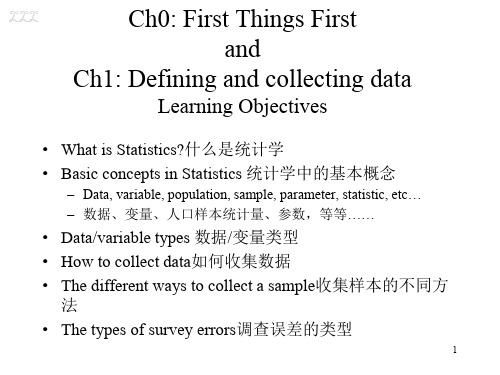
2
LLL
Why Statistics?
• In today’s digital world ever increasing amounts of data are gathered, stored, reported on, and available for further study.
• The growth of “Big Data” spurs the use of business analytics •“大数据 ”的增长刺激了商业分析的应用
• “Big data” or very large data sets are arising because of the automatic collection of high volumes of data at very fast rates. •“大数据”或非 常大的数据集的出现,是因为以非常快的速率自动收集大量数据 6 。
在这个过程中我们将使用DCOVA
– -定义你想研究的数据,以解决问题或达到一个目标。
– -从适当的来源收集数据
– -组织开发表收集的数据
– -通过开发图表来可视化数据
– -分析收集到的数据,得出结论并给出结果
4
LLL
Using The DCOVA Framework Helps You To Apply Statistics To:
No order
ordered/ ranked
No true zero
Absolute zero
Difference is meaningful Difference is meaningful
Ratio is not meaningful Ratio is also meaningful
商务统计学课件第1章(ISEC)

Business Statistics, A First Course (4e) © 2006 Prentice-Hall, Inc.
Hale Waihona Puke Chap 1-4附注在商业世界中,统计学有4种重要的应用。
· 总结商业数据 · 根据数据得出结论 · 作出商业行动的可靠预测 · 改进运营过程
Business Statistics, A First Course (4e) © 2006 Prentice-Hall, Inc.
Chap 1-10
为什么要收集数据?
市场调研者需要了解一个新的旅游产品的效果; 消费者的消费行为方面的信息数据,如:消费者购买产 品的花费、选择的产品渠道、偏好产品的类型、产品使 用周期、购买产品的目的、消费者家庭背景、工作和生 活环境、个人消费观和价值观等。如果企业收集到了这 些数据,建立消费者大数据库,便可通过统计和分析来 掌握消费者的消费行为、兴趣偏好和产品的市场口碑现 状,再根据这些总结出来的行为、兴趣爱好和产品口碑 现状制定有针对性的营销方案和营销战略,投消费者所 好,那么其带来的营销效应是可想而知的。
Business Statistics, A First Course (4e) © 2006 Prentice-Hall, Inc.
Chap 1-16
Types of Data(数据类型)
Data
(属性) Categorical
Examples:
Numerical (数值)
gender belief (Defined categories) 定义属性类别
Probability Theory & Mathematical Statistics 概率论与数理统计
- 1、下载文档前请自行甄别文档内容的完整性,平台不提供额外的编辑、内容补充、找答案等附加服务。
- 2、"仅部分预览"的文档,不可在线预览部分如存在完整性等问题,可反馈申请退款(可完整预览的文档不适用该条件!)。
- 3、如文档侵犯您的权益,请联系客服反馈,我们会尽快为您处理(人工客服工作时间:9:00-18:30)。
Chap 1-9
统计学的基本术语
总体 总体(population)就是所考虑的全部元素。 样本 样本(sample)就是从总体中挑选出来用于分析的一部分。 参数 参数(parameter)就是描述总体特征的概括性度量。 统计量 统计量(statistic)就是根据样本数据计算出来用于描述或估 计总体特征的概括性度量。
统计学的类型
统计学
将数字转化为对决策者有用信息的数学的分支。
统计描述
注重数据的收集、总结、演 示和分析
统计推断
利用从一个小组收集的数据而 得出有关更大组的结论
Chap 1-6
统计描述
数据的收集
例如, 调查
数据的演示
例如, 表格和图形
数据的分析
例如, 样本均值 = X i n
Chap 1-7
商务统计学(第5版)
第1章 概述与数据收集
Chap 1-1
学习目标
在本章中你将学到:
商业中是如何使用统计学的 讨论数据的来源 讨论数据的类型 Microsoft Excel的基本使用 Minitab的基本使用
Chap 1-2
为什么学习统计学?
你能更好地理解普遍使用的数字:
商业备忘录 商业研究 技术报告 技术期刊 报刊文章 杂志文章
组织或者个人已经发布的数据。 可以设计一个实验来获得必要的数据。 可以进行调查。 可以通过观察研究的方式。
Chap 1-14
数据的类型
▪ 属性变量(categorical variables)(也称为定性 变量(qualitative variables))给出定性的回答, 比如是或者不是。
连续的
例子: 重量 电压
(衡量特征)
Chap 1-16
统计学使用的电脑程序
Minitab
进行统计分析的统计包 用来进行尽可能精确的统计分析
Microsoft Excel
多种功能的数据分析工具 有多种功能,但是每一种都没有其他程序那样专注
Minitab和Excel都用工作表来存储收集来分析的数据
▪ Excel中工作表存在于工作簿(workbooks)中,Minitab中则在工程 (projects)中。
▪ 工作簿(workbooks)和工程(projects)都可以容纳数据、总结, 和图表。
Chap 1-18
当正确使用程序时,你应能够:
理解潜在的统计概念 理解如何组织和表示信息 理解如何操作你程序的用户界面 知道如何评论结果中的错误 定和保护清晰命名的工作备份
Chap 1-19
小结
我们在本章中:
▪ 回顾了为啥经理人需要学习统计学 ▪ 介绍了核心概念:
▪ 总体与样本 ▪ 原始与二手数据类型 ▪ 属性与数值数据
▪ 统计描述与统计推断 ▪ 回顾了数据类型 ▪ 讨论了Minitab和Microsoft Excel事项
Chap 1-20
个人观点供参考,欢迎讨论
Chap 1-10
总体与样本
总体
样本
参数是描述总体特征的概括性 度量。
统计量是根据样本数据计算出 来用于描述总体特征概括性度 量。
Chap 1-11
为什么收集数据?
▪ 市场调研者需要了解一个新电视广告的效果。 ▪ 某个研制药物的人员想要知道某种新药是否比当前正
在使用的药物更加有效。 ▪ 某公司的运营经理要改进一个生产或服务过程。 ▪ 某个审计人员要了解公司的财务活动,确认这些活动
▪ 数值变量(numberical variables)(也称为定量 变量(quantitative variables))给出定量的回 答。
Chap 1-15
数据的类型
数据
属性数据
例子: 婚姻状况 政治党派 眼睛的颜色
(定义的类别)
数值数据
离散的
例子: 孩子数 每小时缺陷数
(计数项目)
Chap 1-3
什么是统计学?
将数字转化为对决策者有用信息的数学的分支。 处理和分析数字的方法 帮助减少决策时固有的不确定性的方法
Chap 1-4
为什么学习统计学?
在商业世界中,统计学有4种重要的应用。 ·总结商业数据 ·根据数据得出结论 ·作出商业行动的可靠预测 ·改进运营过程
Chap 1-5
是否符合大家普遍接受的会计准则。
Chap 1-12
数据的来源
▪ 原始来源:数据收集者就是使用数据分析的人
▪ 政治调查的数据 ▪ 实验收集的数据 ▪ 观察的数据
▪ 二手来源:进行统计分析的人不是数据收集者
▪ 分析人口普查数据。 ▪ 从期刊或在互联网上获得数据。.
Chap 1-13
四个主要的数据来源
统计推断
估计 例如, 使用样本的平均体重估计 总体的平均体重
假设检验 例如,检验总体的平均体重是120 磅的说法
利用从一个小组收集的数据而得出有关更大组的结论
Chap 1-8
统计学的基本术语
变量 变量(variable)是项目或者个人的一个特征。 数据 数据(data)就是与变量相联不同的值. 通用的定义
Chap 1-17
Minitab和Microsoft Excel事项
▪ 当使用Minitab或Microsoft Excel时Байду номын сангаас用工作表(worksheets)来存 储收集来分析的数据。
▪ 工作表是列表排列的数据,行和列的相交形成单元(cells)。
▪ 当想要引用一组形成连续的矩形区域的数据是,可以使用单元范围 (cell range)。
